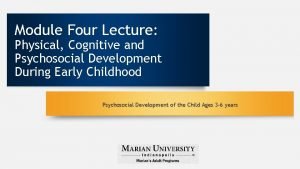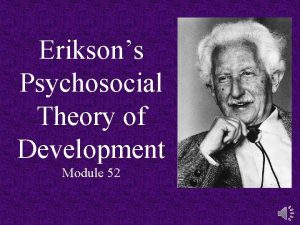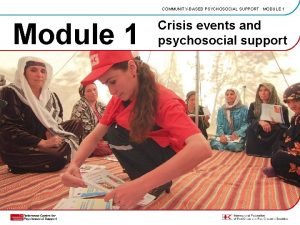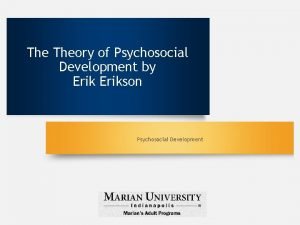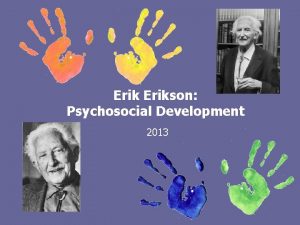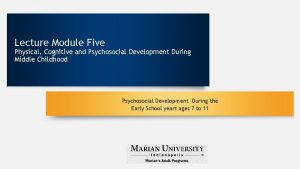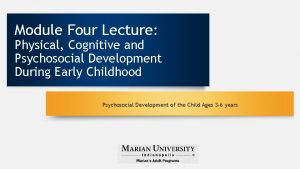Lecture Module Six Physical Cognitive and Psychosocial Development








- Slides: 8

Lecture Module Six Physical, Cognitive and Psychosocial Development During Adolescence Ages 11 ish to 18 ish

What is the Challenge in Adolescence? Your textbook defines adolescence as a developmental transition between childhood and adulthood. How do adults and children differ? Mature Sexual Relating Knowledge of the world and cognitive abilities Importance of friendships, romantic relating and life partnership Take full responsibility for all they are and do and have a career Level of personal knowledge of self The challenge in adolescence is to prepare for all of these adulthood privileges and challenges. To do so you must first know who you truly are! The Challenge of Identity

Prior Ego Strengths The challenge of identity is formidable. Meeting this challenge is greatly abetted by already having realistic optimism for the future, by possessing the capacity to appropriately do things your way, by being able to take charge and make appropriate plans, and by realistically knowing your strengths and weaknesses. The ego strengths of HOPE, WILL, PURPOSE, and COMPETENCE will all come into play in meeting this challenge.

What are the opposing emotional crises emanating from the Identity challenge? Let’s begin by nailing down a concise definition of Identity. • Coherent concept of self including beliefs, goals and values to which one is committed. • The necessity of full commitment to one’s identity gives us a clue as to the bipolar competing tendencies in Erikson’s fifth stage. • On the one hand would be the tendency to really be solid, consistent and fully committed to your concept of self. • On the other hand we would have uncertainty, variable, inconsistent and contradictory aspects to a concept of self that is in flux.

Erikson's 5 th Psychosocial Stage Identity vs. Identity Confusion Adolescents strive to know who they really are & then to remain true to their identity. Early on adolescents typically “try on” identities which they discard in part or whole across time. At first this is a confusing process and teens often feel confused about who they are and what they believe. They change quickly and often in terms of favorite people, music, activities, goals, and future plans.

Erikson's 5 th Psychosocial Stage Cont. Identity vs. Identity Confusion • This absence of solidarity of self concept is often disconcerting and anxiety provoking’. • To lessen the anxiety teens turn to their peers for answers to the “who am I” question. They congregate with other teens who are similar to them and draw identity from group membership. • Cliquishness and defensiveness are defenses against this confusion and the anxiety it creates. View the video on You. Tube: Identity vs. Role Confusion

Resolving identity versus role confusion • Once again we seek balance. The adolescent should become certain about much of their identity BUT not be locked in at this point. They need to be confused enough to be open to exploration of self and the world. • They still lack life experiences to really test who they are and edit their self concept as they go. • You will shortly be reading about James Marcia’s theory on crisis and commitment in making a career choice which makes this point clearly. But they should be settled enough by the end of adolescence to be able to emerge into adulthood with a new ego virtue!

Identity vs. Identity Confusion Resolved If the adolescent can balance the issues of “Who am I” so that they are fairly certain and confident yet open to future editing of self concept, they develop the Ego Virtue of Fidelity: • The capacity to sustain loyalty to ideas, a life path and others. • This is the basis of stability in intimate relating, career and educational goals and faithful allegiance to social institutions. • The emerging adult should possess strengths of hope, will, purpose, competence and fidelity.
 Define physical cognitive and psychosocial development
Define physical cognitive and psychosocial development Trust vs. mistrust
Trust vs. mistrust Ap psych schema
Ap psych schema Module 47 infancy and childhood cognitive development
Module 47 infancy and childhood cognitive development Types of psychosocial support
Types of psychosocial support Reflective and relativistic thinking
Reflective and relativistic thinking Cognitive development during early adulthood
Cognitive development during early adulthood Ego strength erikson
Ego strength erikson Infancy psychosocial development
Infancy psychosocial development
